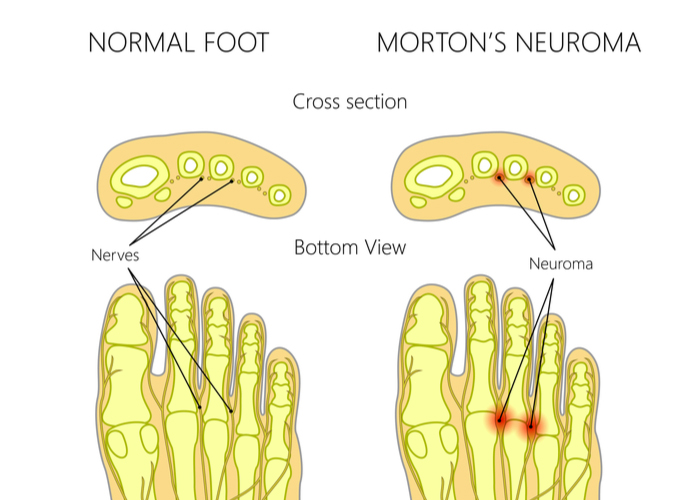Morton’s Neuroma Specialists
Are you experiencing pain at the base of the toes that worsens when pressure is applied to the ball of the foot? If so, you may be experiencing Morton’s Neuroma. This is a condition that occurs when the nerves leading to the toes are compressed by areas of thickened tissue. Morton’s Neuroma is typically diagnosed with an X-ray scan: treatment plans depend on the severity of the condition. Foot and ankle specialists, Doctors Thomas Haytmanek and Jonathon Backus provide diagnosis and specialized treatment plans for patients in Vail and Frisco, Colorado, as well as Denver, Boulder, and surrounding Summit County areas who have nerve pain in the foot. Contact The Steadman Clinic’s Sports Foot and Ankle team today!

What is Morton’s Neuroma?
Morton’s neuroma is a condition which causes pain at the base of the toes—usually described as the metatarsal heads. When present, pain occurs when putting pressure on the ball of the foot and is usually worse bare footed. Most people find that the pain resembles a feeling such as standing on a sharp pebble or marble. Morton’s neuroma often affects the area between the lesser toes and it makes walking difficult because placing pressure of any kind to this region creates the sharp sting or pain.
This condition occurs when the tissue around one of the nerves leading to the toes begins to thicken. Often, this is the result of repetitive injury (exercise) or excessive pressure such as wearing high, tight heels in women.

What are the Symptoms of Morton’s Neuroma?
Symptoms associated with Morton’s neuroma include a sharp, intermittent pain on the ball of the foot when pressure is placed in this region. Many times, a patient will not have any visible symptoms in the area where the pain is coming from. Typically, there will not be a lump or mass that can be seen. This is because Morton’s neuroma occurs inside the ball of the foot and is a benign condition. Many patients also complain of numbness in the toes or a tingling or unpleasant sensation in the toes.
How is Morton’s Neuroma Diagnosed?
Our physicians will conduct a thorough physical examination of the foot and will check for a mass of any kind near and between the toes. During the physical exam, he will place pressure on the areas where the pain is occurring and look for evidence of any other condition that might be causing the pain such as a fracture or bruising. In most cases, we will order an X-ray to confirm and/or rule out that a fracture is what is causing the pain. In most cases, a diagnosis of Morton’s neuroma is accurate once a fracture is ruled out. Typically an MRI or higher level imaging is not needed but some cases this may help further diagnose the neuroma.
Does Morton’s Neuroma Require Surgery?
If an X-ray or MRI shows no fracture, Morton’s neuroma can often be healed conservatively with small changes. Footwear is the first remedy. We will recommend wearing roomier, wider shoes and avoiding high heels. A soft-soled shoe will also be recommended. These small changes in footwear allow the ball of the foot to relax and enable the bones to spread out which helps reduce the pressure on the foot. A metatarsal pad is often recommended. This as a felt or foam pad that is placed in the shoe, just behind the metatarsal heads, and this spreads the forefoot allowing more room for the inflamed nerve. Our physicians may prescribe an injection to help reduce the swelling and pain. In many patients with a Morton’s neuroma, these conservative approaches are successful in relieving the pain.
What is the Surgical Treatment for Morton’s Neuroma?
When conservative treatment, including injections, fails then surgical intervention may be indicated. The surgery involves visualizing the nerve and decompressing or removing the nerve. If the nerve is removed the patient is left with a small area of numbness in the toes but significantly less pain. In most cases, surgery for this condition is usually successful and the recovery period is short and immediate weight bearing is allowed. The surgical approach that is used by our team will depend on the degree of injury.
What is the Recovery Following Morton’s Neuroma?
It is essential that patients follow the post-operative protocol for recovery as set forth by our team as it remains a crucial part of the healing process. Patients are typically allowed to walk in a protective shoe after just a few days. Sometimes patients require the use of an assistive device to make walking easier. Depending on the severity of the injury and the exact surgery performed, patients may resume normal activities within 4-8 weeks.
